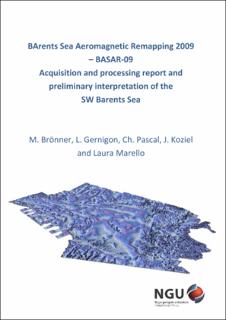| dc.contributor.author | Brönner, Marco | |
| dc.contributor.author | Marello, Laura | |
| dc.contributor.author | Koziel, Janusz | |
| dc.contributor.author | Pascal, Christophe | |
| dc.contributor.author | Gernigon, Laurent | |
| dc.date.accessioned | 2020-07-15T07:41:40Z | |
| dc.date.available | 2020-07-15T07:41:40Z | |
| dc.date.issued | 2010 | |
| dc.identifier.issn | 0800-3416 | |
| dc.identifier.uri | https://hdl.handle.net/11250/2664660 | |
| dc.description.abstract | A high-sensitivity aeromagnetic survey, BASAR-09, was carried out in an area of 106,300 km2 in the Norwegian Barents Sea. Data processing comprised spike-removal and data editing, systematic corrections, and statistical and micro-levelling. Processing and interpretation of the new dataset included a compilation and merger of the surveys in the entire Norwegian Barents Sea. Several potential field maps were produced from the survey area. Examples of various filtering applied to the magnetic field have been illustrated. A depth-to-magnetic source was calculated, applying Euler deconvolution techniques.\rStructural interpretation of the updated aeromagnetic compilation of the southern Norwegian Barents Sea and 2D modelling along four regional seismic lines was carried out in conjunction with the existing gravity data. An existing regional 3D model of the entire Barents Sea was clipped to the Norwegian Barents Sea and refined, updated and readjusted employing the new magnetic data. The new and reprocessed magnetic data represent an important and beneficial improvement to the Norwegian shelf magnetic map, reflecting the regional basement settings with a significantly greater accuracy and providing new insights into the interaction of the various basins and basement highs within the survey area and the complex development of the southern Barents Sea. High-frequency anomalies from shallower structures were utilised to obtain a comprehensive overview of the distribution of dykes and salt diapirism in the area and were helpful in linking and identifying geological structures offshore by onshore-offshore correlations. Grav\/Mag 2D and 3D modelling gave additional information on depth-to-basement, deeper crustal setting and the crustal thickness. A 2D heat flow modelling along one of the interpreted seismic lines gave additional constraints for the different basement units. | |
| dc.language.iso | eng | |
| dc.relation.ispartofseries | NGU-Rapport (2010.056) | |
| dc.rights | Navngivelse 4.0 Internasjonal | |
| dc.rights.uri | http://creativecommons.org/licenses/by/4.0/deed.no | |
| dc.subject | KONTINENTALSOKKEL | |
| dc.subject | BERGGRUNNSGEOLOGI | |
| dc.subject | GEOFYSIKK | |
| dc.subject | MAGNETOMETRI | |
| dc.title | Barents Sea Aeromagnetic Remapping BASAR-09 - Aquisition and processing report and preliminary interpretation of the SW Barents Sea | |
| dc.type | Report | |
| dc.description.localcode | 57047 | |
| dc.source.pagenumber | 210 s. | |
| dc.relation.project | (330600) BASAR-09 Barents Sea Aeromagnetic Remapping 2009 | |

